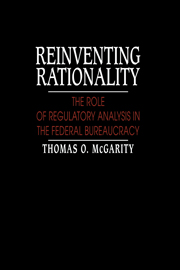Book contents
- Frontmatter
- Contents
- Acknowledgments
- Abbreviations
- Introduction
- Part I The clash of regulatory cultures
- 1 Rational analysis as regulatory reform
- 2 Evolution of the regulatory analysis program
- Part II Regulatory analysis in theory and practice
- Part III Structuring regulatory analysis into the decisionmaking process
- Part IV Review of regulatory analysis
- Part V Conclusions
- Notes
- Bibliography
- Index
1 - Rational analysis as regulatory reform
Published online by Cambridge University Press: 16 October 2009
- Frontmatter
- Contents
- Acknowledgments
- Abbreviations
- Introduction
- Part I The clash of regulatory cultures
- 1 Rational analysis as regulatory reform
- 2 Evolution of the regulatory analysis program
- Part II Regulatory analysis in theory and practice
- Part III Structuring regulatory analysis into the decisionmaking process
- Part IV Review of regulatory analysis
- Part V Conclusions
- Notes
- Bibliography
- Index
Summary
In the late 1960s and early 1970s, astute observers of federal regulation concluded that the cumbersome adjudicatory procedures with which agencies implemented most regulatory actions were ineffectual. Responding to this criticism, many agencies began to use informal procedures to promulgate rules of general applicability. Rather than “put on a case” before an Administrative Law Judge using expert testimony subject to cross-examination and various evidentiary limitations, agencies began to experiment with “paper” rulemaking hearings in which the agency offered a proposed rule and supporting data and analysis for broad public comment. At roughly the same time, Congress enacted a new generation of safety and environmental statutes that empowered, and often required, agencies to govern through informal rulemaking. The “rulemaking revolution” that resulted had the potential to expand enormously the federal government's regulatory powers.
Three themes of regulatory reform
The rulemaking revolution had been under way for less than a decade when regulated industries and some academics began to complain that the federal agencies were going too far. Operating beyond the range of effective political control, they were irrationally imposing burdensome requirements on companies without taking into account their costs or assessing their corresponding benefits. These criticisms and their associated prescriptions for change paraded under the broad banner of regulatory reform.
Some of the critics longed for less burdensome times when administrative agencies were more sympathetic to regulated industries. Unconvinced of the social desirability of government intervention into the marketplace, these critics argued that the only effective solution to the regulatory morass was to remove the dead weight of government regulation from the back of American industry. In this view, regulatory reform meant “regulatory relief.”
- Type
- Chapter
- Information
- Reinventing RationalityThe Role of Regulatory Analysis in the Federal Bureaucracy, pp. 3 - 16Publisher: Cambridge University PressPrint publication year: 1991



